Exploring Dubai's Red Line Metro Stations
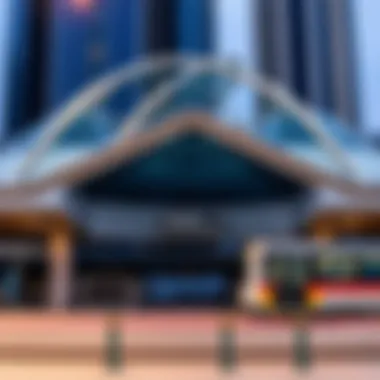
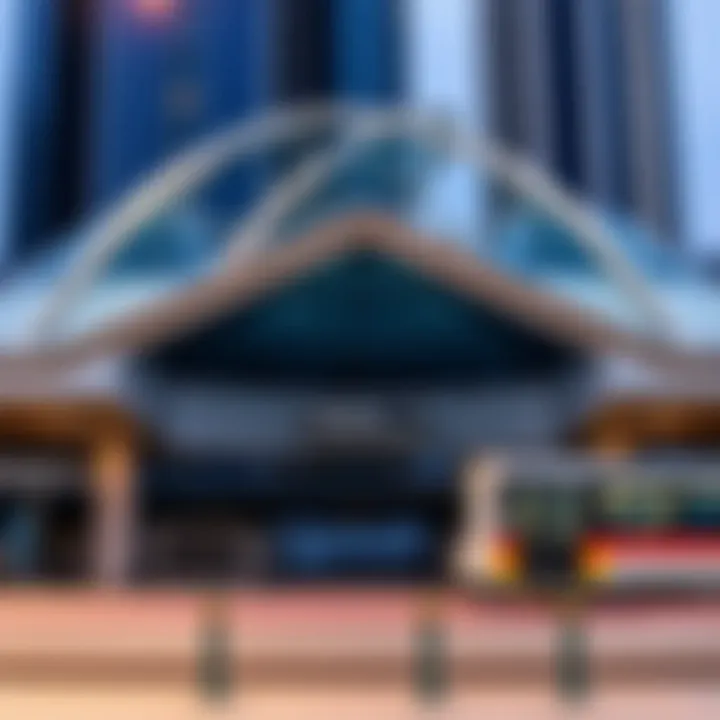
Intro
As Dubai evolves into a bustling global hub, its public transportation network plays a vital role in shaping the city’s growth and accessibility. Among the crown jewels of this network is the Red Line of the metro system. This article embarks on a thorough exploration of the Dubai Red Line metro stations, delving into their pivotal contributions to the city’s infrastructure, architectural allure, and the multifaceted impact they have on surrounding neighborhoods and real estate markets.
Understanding the significance of these stations goes beyond mere transit convenience. Each station not only serves commuters but also acts as a catalyst for regional development, influencing property values and community dynamics. This guide is meant to offer a wealth of information, catering to a diverse range of audiences—from prospective home-buyers to savvy investors eager to navigate Dubai's vibrant real estate landscape. We’ll cover everything from current market trends to key investment opportunities that the vicinity of these metro stations presents.
The journey through this article will highlight:
- The architectural features and designs of the various metro stations.
- The connectivity that each station offers within Dubai and beyond.
- The effects of the metro stations on real estate in local neighborhoods.
- Insights into community offerings, amenities, and future developments.
Whether you're someone looking to invest, a renter scouting an ideal location, or simply curious about these architectural marvels, there's a treasure trove of insights waiting to be unearthed.
Market Analysis
When considering real estate in any city, it’s essential to take stock of the market landscape. In Dubai, the metro system unveils patterns and trends that are crucial for potential property investments.
Current Trends in Dubai Real Estate
Dubai's real estate market has shown resilience even amidst global uncertainties. As people flock to this metropolis from all corners of the world, the demand for accessible living spaces has surged. Proximity to metro stations often translates to higher property values, faster sell-through rates, and a vibrant community lifestyle. Areas near the Red Line, like Dubai Marina and Burj Khalifa, have witnessed significant increases in demand, pushing prices northward as buyers recognize the essence of connectivity.
Historical Market Performance
Delving into historical data, the performance of Dubai’s real estate against the backdrop of the metro system reveals an intriguing correlation. In the wake of major infrastructure projects, property prices in adjoining areas have often experienced a spike. For instance, when the metro system was expanded, nearby neighborhoods saw both residential and commercial properties appreciate substantially. This trend indicates that metro accessibility acts like a lighthouse guiding property values.
To summarize, the connection between the metro stations and local real estate is clear: more than just a way to zip across the city, these stations enhance livability, increase demand, and influence investment potential. Investors and developers alike would do well to keep an eye on the developments sprouting around these transit hubs.
"The metro system is not just a convenience; it’s a key that unlocks value within the real estate market."
Investment Opportunities
Now that we've laid the groundwork regarding market analysis, the next logical step is to explore where the fruitful opportunities lie for investors.
Best Areas for Real Estate Investment
Certain pockets near the Red Line are ripe for investment, appealing to those looking for value. Neighborhoods such as Jumeirah Lake Towers and Business Bay present viable options. They attract a mix of expatriates and locals, creating a diverse rental market. Additionally, areas like Dubai Internet City are undergoing transformation, aided by their proximity to metro access, making them hot spots for commercial investments.
Understanding Property Value Appreciation
Investors must grasp the dynamics of property appreciation in these regions. Typically, properties located near metro stations have exhibited appreciation rates above the city average. Factors such as accessibility, urban planning, and amenities in the vicinity play significant roles in driving these values up. An astute investor should therefore assess not only current prices but also projected infrastructure growth plans when considering acquisitions.
For more information, you may refer to these resources:
- Wikipedia on Dubai Metro
- Britannica overview of Urban Development
- Dubai Land Department
- Reddit discussions about Dubai Living
- Facebook groups related to Dubai Real Estate
This comprehensive examination addresses the vibrant nexus of transportation, real estate, and community life, exemplifying how the Dubai Red Line metro not only reshapes urban landscapes but also bolsters economic growth.
Prolusion to the Dubai Metro System
The Dubai Metro system represents a monumental leap in urban mobility, effectively altering the landscape of the city’s transportation framework. It serves as the backbone of public transit in Dubai, offering an efficient, environmentally-friendly alternative to road travel. This article will unpack the intricate details and significance of the Metro, focusing specifically on the Red Line stations. Understanding the context and functionalities of this system is pivotal for varied stakeholders, from investors eyeing real estate opportunities to commuters seeking reliable public transport.
Historical Context
Tracing back to its conception, the Dubai Metro was born out of necessity. The rapid urbanization of the emirate throughout the early 2000s resulted in burgeoning traffic congestion. Planners recognized the urgent requirement for an interconnected transport system. Consequently, in 2005, the project kicked off, and by 2009, Dubai Metro began its operations with the Red Line. This rail service was not just a means to alleviate traffic woes; it signified a major investment in sustainable transportation, highlighting the UAE's commitment to modernizing its infrastructure while reducing carbon footprints.
In essence, the Metro is more than a public transport network; it symbolizes Dubai’s ambition to blend cutting-edge technology with urban development. Its design showcases contemporary architecture and engineering while facilitating urban planning strategies that mirror sustainability objectives.
Overview of the Metro Network
The Dubai Metro is crucial for meeting the commuting needs of 1.5 million passengers daily and spans a total of 75 kilometers. It comprises two main lines—the Red Line and the Green Line—intersecting at several key stations, thus enhancing connectivity throughout the city. With 47 stations, the trained network showcases state-of-the-art technology, including driverless trains and smart ticketing systems.
Furthermore, the integration of the Metro with other transportation modes, like buses and taxis, enhances its efficiency significantly. The Red Line, which runs from Rashidiya to Jebel Ali, stands out for not just its length, but also the prominent areas it serves, including major landmarks and commercial hubs.
A notable feature of the Metro network is its accessibility. Elevators and ramps are present at many stations, making it user-friendly for families, seniors, and individuals with disabilities. Additionally, the comprehensive signage and announcements cater to a diverse population, ensuring no one feels lost.
Overall, the Dubai Metro system exemplifies a forward-thinking approach to urban transportation, paving the way for economic growth and easing daily commutes. It reflects the vision of a city that continues to push the boundaries of what is possible in modern infrastructure.
The Red Line: An Overview
The Red Line of the Dubai Metro is more than just a transit route; it serves as a vital artery in the heart of the city, connecting commuting locals and visitors alike to various neighborhoods and landmarks. This line is a key player in Dubai's strategy to enhance mobility while promoting sustainable transport solutions. As the first line of the metro system, it laid the groundwork for an extensive network that has drastically reshaped how people navigate in this bustling metropolis.
Route Specifications
The Red Line stretches approximately 52 kilometers, with a track layout that boasts 29 stations, ensuring broad coverage across the city’s vital points. This line runs from Rashidiya to Jebel Ali, allowing easy access to key areas such as the Dubai International Airport, Dubai Marina, and other central hubs.
The train operates at high frequency, with intervals of about five to ten minutes, depending on the time of day. This reliability is further enhanced by the automated, driverless technology that characterizes the Dubai Metro system, making it a pioneer in modern urban transport.

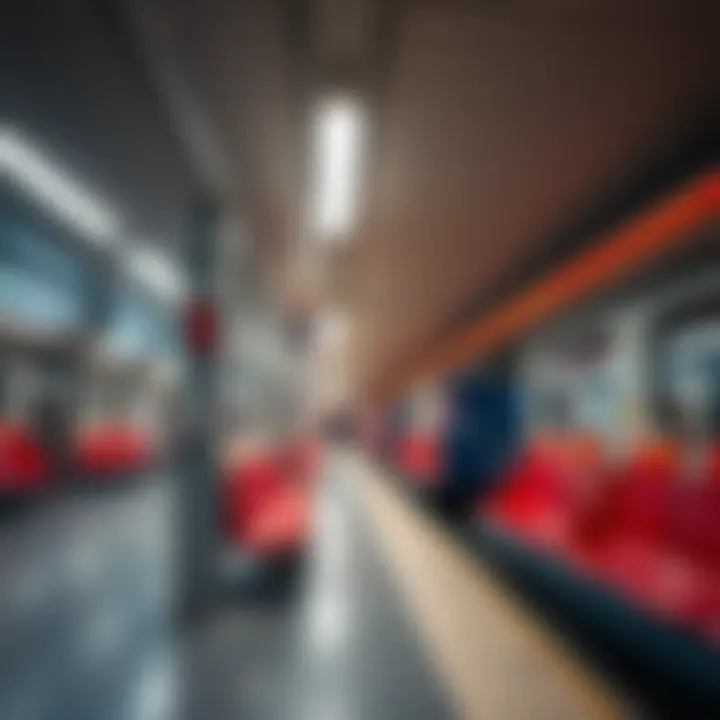
One noteworthy aspect of the route is its above-ground segments, which offer passengers stunning views of Dubai’s skyline. In contrast, the underground sections typically feature unique designs that reflect the city’s cultural heritage, representing a thoughtful blend of functionality and aesthetic appeal.
Key Stations and Connectivity
The Red Line's significance lies not just in the distance it covers, but in the strategic placement of its stations, which promote efficient transfers and widespread connectivity. Notable stations include:
- Burj Khalifa/Dubai Mall Station: Perhaps the most recognizable station, it provides quick access to the world’s tallest building and the luxurious shopping paradise of the Dubai Mall.
- Business Bay Station: Targets professionals working in one of the city’s economic center, catering both to commuters and businesses.
- Dubai Airport Terminal 3 Station: This station facilitates seamless travel for international passengers coming through one of the busiest airports in the world, connecting them directly to the city’s transit system.
Each of these stations is designed with connectivity in mind, integrating with bus networks and facilitating transfers to other modes of transport, including water taxis and tram systems that contribute to a multi-modal transport experience. Additionally, the proximity to major business districts and residential areas enhances the relevance of this metro line in supporting local economies.
As travel demands grow and urban expansion continues, the Red Line is strategically poised to adapt, offering a glimpse into how this critical infrastructure will evolve to meet the needs of its users in the years ahead.
Station Analysis
The analysis of the Dubai Red Line metro stations unfolds significant insights into the city's transportation landscape and urban development dynamics. Each station is more than a mere stop; they represent intricate connections among various facets of city life, from economic activities to accessibility for residents and tourists alike. By exploring the specific attributes of multiple stations along the Red Line, one can better understand how these transit points facilitate movement and contribute to both local and wider economic growth.
UAE Exchange Station
Accessibility Features
UAE Exchange Station stands out for its well-considered accessibility features. Designed with inclusivity in mind, it provides easy navigation for people with disabilities. The station boasts ramps, tactile guiding paths, and lifts, ensuring seamless movement for all users. These elements elevate the user experience significantly, making it not just functional, but a welcoming portal to the rest of Dubai.
One remarkable aspect is its proximity to residential areas, allowing those with mobility challenges to utilize the metro system easily. It not only breaks down physical barriers but also fosters a sense of community by ensuring everyone can participate in the urban experience. Nonetheless, some could argue that occasionally, the busy nature of this station can overwhelm those needing more assistance.
Nearby Developments
The Nearby Developments surrounding UAE Exchange Station add layers to its significance. This area is not just a hub for transit but also for commercial expansion. Recent constructions, including retail spaces and corporate offices, are reshaping the environment into a vibrant marketplace where the station becomes a key facilitator for customers and businesses alike.
Additionally, the strategic location helps in increasing foot traffic, encouraging local businesses to thrive. However, with growth comes challenges such as traffic congestion that can deter visitors from exploring the area fully.
Dubai Airport Terminal Station
Terminal Connectivity
At the Dubai Airport Terminal 3 Station, the connectivity it offers is unparalleled. This station serves as the spine connecting the metro to the bustling Dubai International Airport, making it indispensable for travelers. The direct link between the metro and airport terminal drastically reduces travel times, making it a favorite for those catching flights or meeting arrivals.
Its streamlined access provides flexibility not just to tourists but also to residents in terms of travel options. However, the sheer number of passengers often leads to crowded conditions, which can be daunting during peak hours.
Passenger Amenities
Passenger amenities at Dubai Airport Terminal 3 Station are top-notch. There are lounges, charging stations, and even refreshment areas to ensure travelers are comfortable as they continue on their journey. These features cater to the needs of a diverse group of visitors. Such carefully thought-out amenities reflect a commitment to providing a premium experience.
On the flip side, while most of these amenities are advantageous, their limited availability during late-night hours can pose issues for those on less conventional flight schedules.
Business Bay Station
Commercial Impact
The Business Bay Station is a focal point for economic activity in the area. It serves not only as a transport hub but also as a catalyst for business growth within the financial district. Adjacent office spaces, co-working environments, and startups are thriving, thanks particularly to the constant stream of commuters. Its ability to attract corporations is undeniable, enhancing Dubai’s status as a powerful business gateway.
But with rapid growth, one must consider overcrowding and potential strain on resources. The station's dependence on a high volume of users may lead to challenges in maintaining a smooth operational flow during rush hours.
Surrounding Properties
The Surrounding Properties near Business Bay Station are equally noteworthy. High-profile developments including luxury apartments and upscale hotels are integrated seamlessly into the urban fabric, promoting a modern lifestyle in close proximity to the metro. This increases real estate demand, presenting attractive investment opportunities in the wake of urban transformations.
Despite the growth benefits, the rising property costs might alienate some potential buyers or renters, raising concerns about equitable access to housing.
Burj Khalifa/Dubai Mall Station
Tourism and Real Estate
The Burj Khalifa/Dubai Mall Station captures the fascination of both tourists and real estate enthusiasts. Serving as a gateway to major attractions, it bolsters tourism significantly. The station's geographical relevance enhances visitor accessibility to the world’s tallest building and sprawling malls.
Importantly, this support of tourism also correlates with growth in property values and interest in surrounding real estate. However, the allure of high property values often comes with fierce competition, making it a balancing act for investors.
Retail Opportunities
Retail Opportunities at the Burj Khalifa/Dubai Mall Station are plentiful. The combination of foot traffic from tourists and locals encourages diverse retail options that cater to varying needs and tastes. The embedded retail space within the station and direct links to shopping venues magnify these opportunities.
Nevertheless, the sheer volume of retail options might overwhelm consumers and lead to a saturated market, complicating the landscape for new businesses trying to enter the fray.
Jebel Ali Station
Logistical Importance
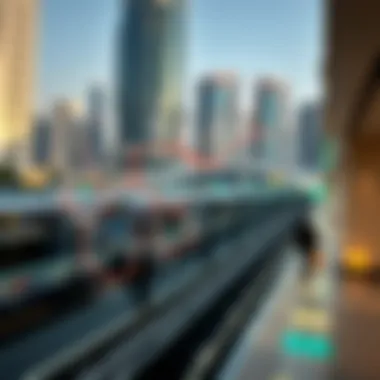

Jebel Ali Station holds a pivotal role in the logistics sector of Dubai. It’s ideally positioned near one of the largest ports in the world, reinforcing its significance for freight and trade activities. Accessibility to major transport routes makes it a focal point for companies reliant on swift logistical operations.
While the station’s logistical placements offer immense advantages, dependency on cargo traffic can lead to fluctuating passenger use, posing risks to operational stability at peak times.
Impact on Trade Facilities
The Impact on Trade Facilities surrounding Jebel Ali Station cannot be overstated. Companies leveraging this station benefit from enhanced operational efficiencies and reduced transportation costs. The station’s integration into the trade network solidifies its role as a resource for both local and international trade.
Yet, one must also address concerns regarding the environmental impact of increased commercial activity in the vicinity. Sustainable practices will be key as the area continues expanding.
Architectural Features of the Red Line Stations
The architectural features of the Red Line stations are more than just aesthetic choices; they represent a fusion of functionality and innovation. These stations are designed with a keen awareness of the unique cultural context of Dubai, ensuring that they not only serve as transit points but also as landmarks that enhance the urban landscape.
An important aspect of the design is how each station reflects modern architectural trends while also accommodating the practical needs of riders and local communities. The use of space, materials, and technology involved in the design contributes to both the user experience and the overall operational efficiency of the metro system.
Design Elements
The design elements of the Red Line stations exhibit a striking blend of contemporary style and local heritage. Simple yet elegant lines characterize the superstructures, built with high-strength materials that can withstand the scorching desert heat. You’d likely notice the distinctively curved roofs that not only add a dynamic feel to the station but also improve natural ventilation, reducing reliance on energy-consuming air conditioning.
- Architectural Style: The design harkens back to traditional Islamic architecture with a modern twist, integrating geometric patterns and fluid forms.
- Functional Layout: A key focus is on accessibility. Clear signage and spacious waiting areas are designed to accommodate high passenger volumes, ensuring a smooth flow during peak hours.
- Aesthetics: Glass facades not only provide a visual connection between the station and the city but also create a welcoming atmosphere for travelers. Each station is akin to a gallery, showcasing art from local artists that enriches the commuter experience.
These thoughtful design elements elevate the aesthetic appeal of the Red Line, promoting a sense of pride among locals and attracting visitors.
Sustainability Initiatives
Sustainability plays a pivotal role in the architecture of the Red Line stations. The Metro project was not just about building a transit solution but also about creating a greener, more sustainable urban environment. Throughout the construction phase and ongoing operational practices, various initiatives have been integrated.
One of the foremost sustainability practices is the incorporation of solar panels on station roofs, providing renewable energy to power station lighting and systems.
- Water Management: Rainwater harvesting systems are in place to collect and reuse water for landscaping and cleaning, reducing dependency on municipal water supplies.
- Energy Efficiency: Intelligent building management systems optimize energy use, ensuring that lighting and HVAC systems adapt to the number of passengers present.
- Materials Sourcing: Many materials used are sourced locally, which not only reduces transportation costs but also supports local industry.
Such sustainability initiatives reflect a commitment to reducing the environmental footprint of the metro system while enhancing the quality of life in Dubai.
The Red Line stands as a testament to the possibility of integrating modern infrastructure with sustainable practices, fostering both economic growth and environmental stewardship.
Overall, the architectural features of the Red Line stations provide functional, aesthetic, and sustainable benefits that are critical for a city like Dubai, positioning the Metro system as a vital component of an interconnected urban landscape.
Impact on Local Communities
The impact of the Dubai Red Line metro stations on local communities cannot be understated. These stations serve as lifelines, not just as transit points, but as catalysts for economic development, social interaction, and urban growth. The connective tissue they provide extends beyond mere transportation; they weave a network that binds various communities together while shaping city dynamics.
Socioeconomic Development
When exploring socioeconomic development, it’s essential to acknowledge how the Red Line stations have uplifted surrounding neighborhoods. With the metro offering reliable transportation, residents now find access to job markets previously out of reach. This opens doors to employment opportunities in diverse sectors such as hospitality, retail, and technology. For instance, areas like the Business Bay or Burj Khalifa stations have become hotspots for high-paying jobs, attracting a steady flow of professionals.
Moreover, the influx of people utilizing the metro boosts local businesses. Cafes, retail shops, and service-oriented establishments flourish in proximity to these stations. This growth often leads to a more vibrant community life, where economic activity encourages social interactions and enhances the quality of life for residents. As property values rise, homeowners see returns on their investments, and new developments spring up, enriching the local economy further.
Benefits of Socioeconomic Development
- Increased Employment Options: Access to varied job sectors enhances the overall standard of living.
- Local Business Growth: Higher foot traffic around stations means more customers for local shops and services.
- Rising Property Values: Investments in infrastructure generally lead to better property valuations and home equity.
- Community Interaction: Enhanced social spaces may emerge as diverse groups come together, fostering inclusivity.
Transport Accessibility
The role of the Red Line in enhancing transport accessibility is another critical factor that cannot be overlooked. The geographical distribution of the metro stations directly influences how easily residents can navigate through the city. For instance, a resident near the UAE Exchange Station can quickly reach the Dubai Airport Terminal 3 in under an hour. Ease of movement reduces congestion on the roads, offering a more environmentally sustainable alternative to car travel.
Accessibility isn’t only about distance; it’s also about convenience and reliability. Metro trains in Dubai have a reputation for efficiency, running frequently throughout the day. The availability of dedicated tracks and the absence of traffic means that commuters spend less time in transit, freeing up more time for personal or professional activities. This reliability enhances trust in public transport, encouraging more people to switch from private vehicles to mass transit solutions.
Additionally, for those with disabilities or mobility challenges, Red Line stations are increasingly equipped with accessibility features. Elevators, ramps, and clear signage contribute to making public transport an option for everyone. Thus, knowledge of these advancements expands a community's options and enhances the quality of public transport.
In summary, the Dubai Red Line stations have far-reaching effects on local communities, influencing socioeconomic development and vastly improving transport accessibility. As the city grows, so does the importance of these stations as pivotal elements within Dubai's transport infrastructure and community fabric.
Real Estate Dynamics Near Red Line Stations
Delving into the real estate dynamics surrounding the Red Line stations reveals a multi-layered narrative filled with opportunities and significant shifts in the market landscape. As the backbone of Dubai's public transport, the Red Line influences property values and shapes investment prospects for a myriad of stakeholders, including investors, realtors, developers, buyers, and renters. The intertwinement of metro transit with real estate is profound, especially in a rapidly growing metropolitan area such as Dubai, where location can mean everything.
Property Value Trends
The evolution of property values near Red Line stations is a compelling story of growth and opportunity. Over the years, properties located within proximity to metro stations have seen a steady rise in value, driven by increased demand for accessibility and convenience. Properties near key stations like Burj Khalifa/Dubai Mall and Business Bay have notably boomed, where appreciation rates have regularly outpaced the average in Dubai.
Factors contributing to this trend include:
- Accessibility: The ease of commuting via the metro significantly appeals to residents and businesses, encouraging higher occupancy rates.
- Demand for Urban Living: With an influx of people moving to Dubai for work and lifestyle, the desirability of centrally located properties continues to rise.
- Commercial Development: The construction of offices, shops, and dining establishments near metro stations enhances local amenities, further driving up property values.
"Investing near metro stations is not just a trend; it's become a strategic necessity for harnessing Dubai's growth potential."
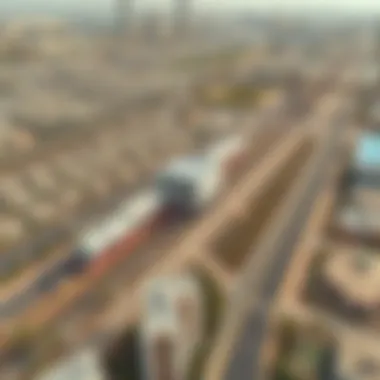

Despite some fluctuations in the market, the long-term outlook remains promising. Investors keeping an eye on emerging trends can capitalize on shifts by targeting areas with new or upcoming station developments, ensuring they stay ahead of the curve.
Investment Opportunities
The landscape of investment opportunities near Red Line stations is not merely about purchasing properties but also about exploring innovative projects that leverage the metro's connectivity. Potential areas ripe for investment include:
- Residential Developments: New housing projects near stations cater to the growing population seeking rental units and homes for purchase.
- Commercial Real Estate: The demand for office spaces close to public transport is escalating, ushering in developments tailored for businesses looking to attract talent.
- Mixed-Use Developments: Projects combining residential, commercial, and leisure facilities are increasingly succeeding, ensuring vibrant community hubs that appeal to diverse occupants.
- Retail Spaces: This includes convenience stores, cafes, and restaurants, which thrive under foot traffic generated by metro users.
Investors ought to conduct diligent research, focusing on areas slated for expansion or developments that will enhance existing facilities. Engaging knowledgeable local real estate agents can provide invaluable insights into lucrative opportunities.
Future Developments in the Metro Network
Future developments in the Metro network are crucial for maintaining Dubai's status as a leading global city. As the demand for efficient urban transport escalates, the existing infrastructure needs to evolve. Enhancements not only improve connectivity but also play a significant role in driving local economic growth and sustainable urban living.
Proposed Extensions
One of the most talked-about aspects of future developments is the proposed extensions of the Red Line. These expansions aim to improve accessibility to the far reaches of the city, connecting previously underserved neighborhoods and key economic hubs.
- Expanding Reach: The Metro's reach could extend to outlying areas, like Dubai South and Dubai Silicon Oasis. This would help to better integrate these districts into the city's broader transport grid.
- Boosting Employment Opportunities: With new stations, professionals living in the suburbs can easily commute to major business districts, thus reducing traffic congestion and lowering carbon footprints.
- Timeline and Phases: Development is planned in stages, with initial projects expected to break ground within the next few years. Updates will be communicated through government portals, ensuring community engagement and transparency.
In addition to these extensions, the improvements are also set to encompass modern technological upgrades, including smarter signaling systems, better crowd management solutions, and enhanced overall user experience.
Integration with Other Transport Modes
Integrating the Red Line with other transport modes is ont he docket for future developments.
- Seamless Transfers: The goal is to facilitate seamless transfers between the Metro, buses, and taxis. Such connectivity will create a user-friendly environment for commuters, making them more likely to opt for public transport over personal vehicles.
- Last-Mile Connectivity Solutions: Initiatives like bike-sharing and ride-hailing partnerships could be introduced. By ensuring all transport options connect smoothly, the city can enhance overall mobility.
- Expected Benefits: This integration can significantly decrease reliance on cars, thereby reducing road traffic and pollution levels. Furthermore, it promises to make daily commutes a breeze, attracting a larger portion of the population to utilize public transport.
In summary, the future developments in the Metro network lookout promising in transforming the current urban landscape. As extensions roll out and integration efforts materialize, Dubai's vision for a pioneering infrastructure will come closer to fruition.
**"Efficient transport systems play a pivotal role in shaping the future of urban life. Improving connectivity will only enhance Dubai’s reputation as a progressive city."
Links for further reading:
Current Challenges and Solutions
The Dubai Red Line metro system stands as a testament to modern engineering and urban planning. However, like any large-scale infrastructure, it faces its own set of challenges. Understanding these challenges is crucial for stakeholders such as investors, realtors, and developers. Tackling these issues not only enhances the efficiency of the metro system but also contributes to the overall improvement of urban transit solutions in Dubai.
Operational Hurdles
In a bustling metropolis like Dubai, the Red Line is often a lifeline for commuters. Yet, operational hurdles frequently arise that hamper its effectiveness. Some of the notable challenges include:
- High Passenger Volume: During peak hours, the influx of passengers could be compared to a flood. The trains can become incredibly congested, leading to discomfort and delays.
- Maintenance Issues: Although maintenance is scheduled for off-peak hours, any unanticipated technical glitches can derail operations, causing ripple effects throughout the transit system.
- Safety Concerns: Ensuring passenger safety is paramount, and with a growing user base, the demand for stringent safety measures has never been higher. As new risks emerge, continuous improvement in safety protocols is critical.
All these operational hurdles not only affect daily commuters but can impact real estate developments surrounding the stations. Investors must recognize that heightened congestion could affect property values near the stations if the issues aren't addressed properly.
Technological Innovations
To mitigate the challenges faced by the Red Line, embracing technological innovations is essential. In today’s digital age, there are several avenues to enhance the functionality and experience of the metro, including:
- Smart Ticketing Systems: Advanced electronic ticketing solutions can streamline the boarding process, drastically reducing wait times at entry points.
- Passenger Information Systems: Real-time updates through mobile apps or screens can keep commuters informed about train schedules and any operational delays, directing them to alternative routes if necessary.
- Safety Enhancements: Implementing AI and machine learning analytics can lead to predictive maintenance, catching potential equipment failures before they happen, thereby increasing station safety and performance.
"Investing in technology isn't just about keeping up; it's about staying ahead—and the Red Line's future may very well depend on it."
By addressing operational hurdles through innovative technology, we not only improve the metro system but also enhance the attractiveness of the surrounding areas, appealing to both investors and potential residents. Thus, ongoing evaluations and advancements in operations and technology are paramount to uphold the integrity and reputation of the Dubai Red Line metro.
The End
The conclusion serves as a pivotal component of this article, encapsulating the significance of the Dubai Red Line metro stations and their multifaceted impact on the city’s urban landscape. The Red Line is more than just a transportation corridor; it symbolizes the growth and ambition of Dubai as a modern metropolis. Understanding this context allows for a deeper appreciation of what the metro brings to the table for investors, developers, and residents alike.
Summary of Findings
Diving into the detailed examination of each station reveals several key insights:
- Structural Significance: Each station, from UAE Exchange to Burj Khalifa, showcases a unique architectural style designed to enhance passenger experience while integrating effortlessly with the urban environment.
- Economic Uplift: The Red Line has stimulated significant real estate activities, boosting property values and attracting a plethora of businesses in proximity to the stations.
- Enhanced Connectivity: With connections to airports and commercial hubs, the stations are vital for not just commuters but also tourists, fostering a vibrant economic atmosphere.
- Future Potential: Proposed extensions and enhancements indicate that the network is set for growth, promising even more connectivity and opportunities for stakeholders.
Through these findings, it becomes crystal clear that the Dubai Red Line is integral to the city’s identity and economic framework.
Final Thoughts on the Red Line's Role in Dubai
The Red Line’s integration into Dubai's public transport is not merely a logistical advancement; it becomes a lifeline for the city’s socio-economic fabric. This metro line unites various neighborhoods, bridging gaps that once existed in urban mobility. The introduction of advanced technology and sustainable practices within the metro system underscores Dubai’s commitment to a smarter, greener future.
The benefits transcend transportation; they ripple through the real estate market, constructing an ecosystem where businesses flourish, residents thrive, and visitors are welcomed. As developers and investors keep a keen eye on this evolving landscape, it is evident that the Red Line will continue to reshape Dubai's narrative.
Ultimately, reviewing the significance of the Red Line reveals not only a transportation solution but a cornerstone for Dubai's vision as a global city. The way forward seems bright, and its impact will echo in the lives of many, forming a crucial thread in the vibrant tapestry of the city.
“In every city, public transport is a reflection of its people and their way of life; the Dubai Metro is a testament to innovation.”
For more information regarding Dubai’s public transport dynamics, visit
Wikipedia,
Britannica, and
Reddit.
Join the conversation about urban development and public transport on
Facebook.











